We learn from a master popiah maker how to make the skins for this popular roll by hand, from scratch.
It all started on our friend Mike’s blog with his post about his cousin making popiah skin. I commented that we should have a popiah making party; a couple months later, his cousin was back in town and he invited us to come over to his house to watch and learn. According to him, his cousin put her three children through college by selling her popiahs at the night market. That makes her a master in my book!
For Starters
Popiah (also spelled “poh pia”) is a fresh spring roll. Think of it as an Asian burrito. Only instead of a thick, doughy flour wrapper, popiah are made with a very thin, crepe-like sheet or “skin”. This skin is made by smearing a ball of dough onto a hot griddle and letting it cook for a few seconds before removing it. The technique to get a uniformly thin skin is a skill that takes many months of practice.
The dough starts out as a thick batter. The ingredients for the batter are
1 kg flour
4-1/2 cups water
1 Tsp salt
2 Tbsp tapioca flour
You mix all the ingredients together until they make a lumpy batter:
But you don’t stop there. The next step in the process is to knead the batter by repeatedly lifting it up and slamming it back down into the bowl until it starts to hold together in ropes. Here’s a short video demo of how she did it, to show the result she was looking for:
After that, the dough is placed in the fridge overnight to rest and continue to develop. The next day, the dough is more solid and less tacky.
Are We Having Fun Yet?
Now comes the fun part: cooking the skins. First, you need a wide, seasoned griddle (preferably cast iron). Heat it on a medium flame. Dipping your hand into the container of dough, scoop out a generous lump and pinch it off, winding the dough and gathering it into the cup of your hand.
Now take that lump and smear it quickly and smoothly in a big circle on the griddle. Pull up quickly so that only the dough that makes contact with the griddle actually sticks. There may be some high spots of dough remaining on the crepe so flick the dough in your hand down onto the spot to pick them up (the motion is kind of like playing with a yo-yo). Wait a few seconds while the moisture cooks off. When you see the edge of the crepe start to curl up, carefully peel off the skin and place it on a plate.
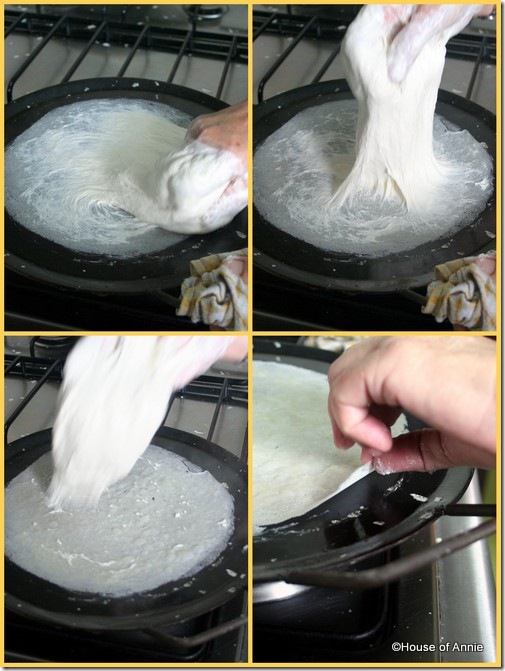
Watch how effortlessly she does it in this video! It’s like magic. (She’s speaking Hokkien, in case you’re wondering.)
Of course, we each had our turns at throwing the dough and smearing the skins. Believe me, it wasn’t pretty! I don’t know how much dough I wasted, but I know I made quite a mess. I think I managed to get one or two good skins out of my attempts.
So, why make your own popiah skins?
Most of the skins available nowadays in Singapore and Malaysia are machine-made. In America, you can’t even get fresh made ones – you have to rely on frozen spring roll wrappers. Machine-made ones are okay only, but they can’t match the thinness, springiness or durability of a freshly hand-made popiah skin. Only a fresh, hand-made popiah skin can hold together all the popiah fillings without bursting or leaking.
Mike’s cousin’s popiahs were very special, and not just because of the homemade skins. The filling for her popiahs consisted of items we’d never seen used before, like crushed, twice-fried you tiau, fried minced hae bee and fried and minced dried fish. They were really amazing.
BUT we’re not going to talk about that popiah. Annie’s Mum, in our opinion, makes the best popiah. So in our next post we will talk about her recipe.
Stay tuned!
Aloha, Nate
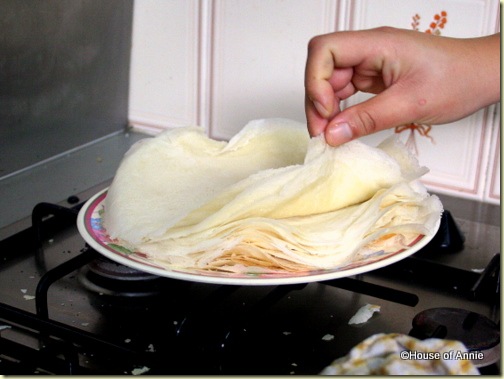
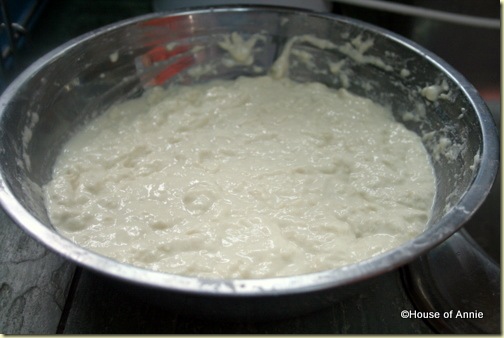
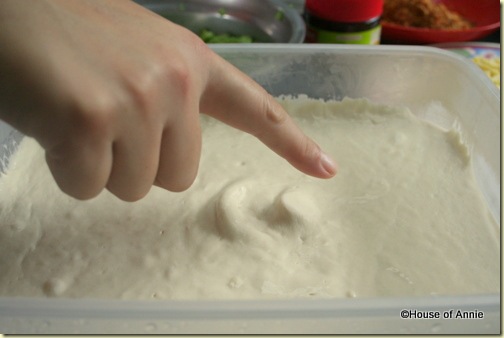
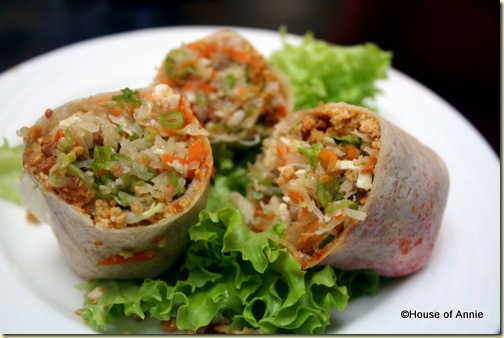
I had made one sample patch few days ago… the dough is ok and I am still not good at getting the dough to stick nicely on to the hot pan. I starting another patch today and hoping that it will turn out better than the last. It taste very nice even it did not look nice on my first patch of trying.l
Thanks so much for giving us the recipe.
Hi,
where to buy the flat iron cast to cook the skin?
thanks!
Hi,
I’m really interest in making skin popiah, but could you honestly tell me the type (brand) of flour dan measurement. tq
Exactly what I was looking for. Fresh Popiah!
Hi,
Your poh piah skin looks really good! I have some questions: do they freeze well? And if so what’s the best way to reheat– microwave, steam on stove or no reheat required?
Like you said, store bought frozen poh piah wraps (made in Philipine) tears too easily. I tried lightly steam them but they all stuck together and became stiff after cooling… I love poh piah, so I guess I’ll have to make the skin from scratch.
Thanks for sharing!
Regina,
Thanks for your question.
In my experience, fresh popiah skins do not freeze well. They must be kept at room temperature, wrapped in a dish towel. Do not try to steam them.
On all videos and webpages i come across, flour is just mentioned, but not specified as to what flour. Is it rice flour that is being used, and if not can rice flour be used successfully to make these? I have seen rice made wrappers but they seem to be for fresh spring rolls, and not for frying, or can they also be fried. I would love to enjoy these but I am wheat intolerant.
Justine,
it’s wheat flour. I don’t think you can make these kinds of popiah skins using rice flour because you need the gluten for springiness.
If you use rice paper wrappers to make popiah, you can make them either fresh or deep fried.
hola soy de argentina la masa sale bien pero como se llama o como conseguir el sarten del video?algo parecido,y si puedes es saber cantidad exacta en el kilo de harina cuanta agua desde ya muchas gracias.perdon cuanto tiempo se golpea la masa?
Gaston,
if you have a large, flat iron pan or griddle to make tortillas, you can use that to make these popiah skins. The ingredients are found in the post.
hola queria saber cuanto tiempo de amasado?es mejor en maquina?y cuanto tiempo en maquina?lo pregunto por la elasticidad,la elasticidad se la da la formacion de gluten pero algo falta para que salga excelente,saludos
a me olvidaba cuanta agua es porque es el post dice la cantidad en taza cuanto seria en litros
It’s approximately 1 liter of water to the 1 kg of flour.
You knead it until the gluten starts forming as in the video. Yes, you could use a machine but I don’t know how long that would take.
que cantidad de agua lleva en un kilo de harina 000 de trigo
cuanto tiempo es el amasado a mano porque el video son 24 seg
hola que harina uso(000) tres cero o cuatro ceros??????(0000) gracias
All-purpose (000) should be fine.
Hi thanks for your recipe.
I am from mexico and we use diferent kind of tortillas is like the popiah but more fat lol, i mix all the ingredients and i think looks like in the videoand leave rest in the fridege all night, in the morning when i try to make the popiah skin, the **masa** not have the stikly like the video, and the popiah comes with the **masa** when i pulled up, and if i put the fire too low the popiah look so thik, i want to know what i am doing wrong….. Thanks for you time.
hello, i love your food, and i tried to make this recipe, but i didnot had tapioca flour, how i make it?
Hi,
I have never heard of this Popiah, but I wanna thank you for the recipe…’coz I wanna cook it one day!
There’s a similar food to this in Filipino recipe, we call: Lumpiang Hilaw or Raw Lumpia, and the dough is almost similar, only softer in consistency, but is also filled with vegetables! But we do make it a very delicious sauce with Sugar and soy sauce on garlic and roasted peanuts! Try google: LUMPIANG HILAW or LUMPIANG SARIWA!
Hello Annie!
I just want to thank you for helping me with the technique of making these papers!
I have made a wheat/gluten/egg/rice free version of the papers and have given you a mention lovely.
http://josephine-eliza.blogspot.com/2014/02/gluten-rice-egg-wheat-free-spring-roll.html?m=1
So thank you again for your very clear instructions xx
Josephine,
you’re welcome! Thanks for the link. I will share it to our followers.
Hello,
I am a singaporean living in europe and I was looking around for a popiah skin recipe and found yours. Thanks for sharing! I would like to know if it is possible to make this on a normal frying pan instead of a griddle? Have you tried it before? Thanks for the reply. Appreciate it!
Jacqueline,
thanks for your question. We have tried it with a non-stick frying pan, and it doesn’t work as well as a cast-iron griddle. The popiah dough needs to stick a little so that it will cook.
Good luck!
thank you is the best tutorial !!!!!!!!!!!
Thanks for the recipe, but can it be fried after fiilling, will it be crispy?
Yes, you can pan-fry it crispy.
May I know how do I get the popiah skin machine ?
Hi, where can I buy fresh poppiah skin in PJ or
KL area? Can you please provide telephone /
address details.
Thanks
Takes lots of trial and error as well as practices to get it right cos it’s not just skill and technique. It is also the art of balancing and controlling the dough while making each skin.
One can also used a non-stick shallow frying pan say 28cm or 30cm. Just be careful not to contact your fingers with the edge of the pan. This is what I used to make this poh pia skin as well as nonya type poh pia skin which is thicker like a crepe.
It’s ideal to make poh pia skin for those who appreciate healthier homemade foods. It’s all about making an effort.
Thank you
how much the amount of water in the dose measuring cups, water what is used if the water is warm or indifferent,thanks before
Hi,
Can you please tell me do we need to grease the griddle first? I have a cast iron Tawa. Can you use it to make the skin?
Thank you
Sophie,
thanks for your question. Mike’s cousin used a piece of pork fat to grease the griddle.
Where can I buy the hot plate that is in use in the video for making the popiah skin? Any particular shop or brand that you would recommend? I have experimented with everything else I have in my kitchen and nothing works. Either the skin won’t stick or sticks so much, it won’t come off and ends up burnt.
Hi where to buy the wok for making the skin pls?
Hi, can you write the recipe in ml and gram? thank you